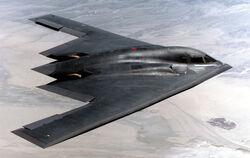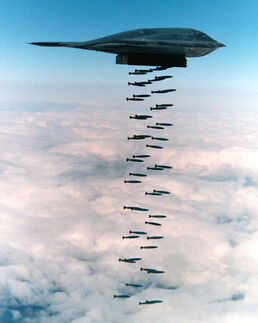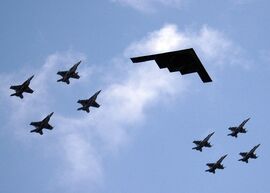JBiz (Message Wall | contribs) (I touched this page up a bit since it was only about a paragraph long. I've never edited a wiki page before so if I did something wrong or messed something up I'm sorry.) |
JBiz (Message Wall | contribs) (→Design) |
||
| Line 11: | Line 11: | ||
The B-2 Spirit was the product of Advanced Technology Bomber (ATB) project that began in 1979. The project came down to two contestants. One from Northrop/Boeing and the other from Lockheed/Rockwell. Each recieved a study contract for further work. On October 20th 1981 the Northrop/Boeing design was chosen over the Lockheed/Rockwell design and received the designation B-2 and the name "Spirit". A procurement of 132 aircraft was planned and was later reduced to 75. When the Soviet Union fell in the early 1990's and the B-2's primary cold war mission was effectively eliminated. Budgetary issues brought the B-2's production to a halt in 1992 with 20 having been produced. In 1996 a prototype model of the B-2 was converted to operational standards of the time bringing the number of B-2's to 21.[[File:B-2_spirit_bombing.jpg|thumb|258px|A B-2 Spirit dropping Mk.82 bombs during a training exercise.]] |
The B-2 Spirit was the product of Advanced Technology Bomber (ATB) project that began in 1979. The project came down to two contestants. One from Northrop/Boeing and the other from Lockheed/Rockwell. Each recieved a study contract for further work. On October 20th 1981 the Northrop/Boeing design was chosen over the Lockheed/Rockwell design and received the designation B-2 and the name "Spirit". A procurement of 132 aircraft was planned and was later reduced to 75. When the Soviet Union fell in the early 1990's and the B-2's primary cold war mission was effectively eliminated. Budgetary issues brought the B-2's production to a halt in 1992 with 20 having been produced. In 1996 a prototype model of the B-2 was converted to operational standards of the time bringing the number of B-2's to 21.[[File:B-2_spirit_bombing.jpg|thumb|258px|A B-2 Spirit dropping Mk.82 bombs during a training exercise.]] |
||
==='''Design'''=== |
==='''Design'''=== |
||
| − | The B-2's "stealth" capabilities |
+ | The B-2's "stealth" capabilities comes from composite materials, special coatings and flying wing design, which reduces the number of leading edges. Many of the specifics of the B-2's "stealth" remain classified. The engines are buried within the wing to conceal the induction fans and hide their exhaust. Each B-2 requires a climate-controlled hangar large enough for its 172-foot wingspan to protect the operational integrity of its sophisticated radar absorbent material and coatings. The U.S. Air Force reports its range as approximately 6,000 nautical miles (6,900 mi; 11,000 km). It combines GPS Aided Targeting System (GATS) with GPS-aided bombs such as Joint Direct Attack Munition (JDAM). This uses its passive electronically scanned array APQ-181 radar to correct GPS errors of targets and gain much better than laser-guided weapon accuracy when "unguided" gravity bombs are equipped with a GPS-aided "smart" guidance tail kit. It can bomb 16 targets in a single pass when equipped with 1,000 or 2,000-pound (450 kg or 900 kg) bombs, or as many as 80 when carrying 500 lb (230 kg) bombs. The B-2 has a crew of two: a pilot in the left seat, a mission commander in the right , and has provisions for a third crew member if needed. |
| + | |||
==='''Operational History'''=== |
==='''Operational History'''=== |
||
The first operational aircraft, christened ''Spirit of Missouri'', was delivered to Whiteman Air Force Base, Missouri, where the fleet is based, on 17 December 1993. The B-2 reached initial operational capability (IOC) on 1 January 1997. |
The first operational aircraft, christened ''Spirit of Missouri'', was delivered to Whiteman Air Force Base, Missouri, where the fleet is based, on 17 December 1993. The B-2 reached initial operational capability (IOC) on 1 January 1997. |
||
Revision as of 00:40, 10 April 2011

A flying B-2
The B-2 Spirit is a unique stealth heavy bomber built with flying wing and is built by Northrop Grumman for the United States Air Force. They are designed to penetrate areas of highly dense anti-aircraft defenses that would be hard or impossible to penetrate by conventional aircraft.
Description
History
The B-2 Spirit was the product of Advanced Technology Bomber (ATB) project that began in 1979. The project came down to two contestants. One from Northrop/Boeing and the other from Lockheed/Rockwell. Each recieved a study contract for further work. On October 20th 1981 the Northrop/Boeing design was chosen over the Lockheed/Rockwell design and received the designation B-2 and the name "Spirit". A procurement of 132 aircraft was planned and was later reduced to 75. When the Soviet Union fell in the early 1990's and the B-2's primary cold war mission was effectively eliminated. Budgetary issues brought the B-2's production to a halt in 1992 with 20 having been produced. In 1996 a prototype model of the B-2 was converted to operational standards of the time bringing the number of B-2's to 21.

A B-2 Spirit dropping Mk.82 bombs during a training exercise.
Design
The B-2's "stealth" capabilities comes from composite materials, special coatings and flying wing design, which reduces the number of leading edges. Many of the specifics of the B-2's "stealth" remain classified. The engines are buried within the wing to conceal the induction fans and hide their exhaust. Each B-2 requires a climate-controlled hangar large enough for its 172-foot wingspan to protect the operational integrity of its sophisticated radar absorbent material and coatings. The U.S. Air Force reports its range as approximately 6,000 nautical miles (6,900 mi; 11,000 km). It combines GPS Aided Targeting System (GATS) with GPS-aided bombs such as Joint Direct Attack Munition (JDAM). This uses its passive electronically scanned array APQ-181 radar to correct GPS errors of targets and gain much better than laser-guided weapon accuracy when "unguided" gravity bombs are equipped with a GPS-aided "smart" guidance tail kit. It can bomb 16 targets in a single pass when equipped with 1,000 or 2,000-pound (450 kg or 900 kg) bombs, or as many as 80 when carrying 500 lb (230 kg) bombs. The B-2 has a crew of two: a pilot in the left seat, a mission commander in the right , and has provisions for a third crew member if needed.
Operational History
The first operational aircraft, christened Spirit of Missouri, was delivered to Whiteman Air Force Base, Missouri, where the fleet is based, on 17 December 1993. The B-2 reached initial operational capability (IOC) on 1 January 1997.
Kosovo War
The B-2 has seen service in four campaigns. Its combat debut was during the Kosovo War in 1999. It was responsible for destroying 33% of selected Serbian bombing targets in the first eight weeks of U.S. involvement in the War. During this war, B-2s flew non-stop to Kosovo from their home base in Missouri and back. The B-2 was the first aircraft to deploy GPS satellite guided JDAM "smart bombs" in combat use in Kosovo.
War in Afghanistan
The B-2 has been used to drop bombs on Afghanistan in support of the War in Afghanistan. With the support of aerial refueling, the B-2 flew one of its longest missions to date from Whiteman Air Force Base, Missouri to Afghanistan and back.
War in Iraq
During the War in Iraq, B-2s operated from Diego Garcia and an undisclosed "forward operating location". Other sorties in Iraq have launched from Whiteman AFB. This resulted in missions lasting over 30 hours and one mission of over 50 hours. The designated "forward operating locations" have been previously designated as Gaum and RAF Fairford, where new climate controlled hangars have been constructed. B-2s have conducted 27 sorties from Whiteman AFB and 22 sorties from a forward operating location, releasing more than 1.5 million pounds of munitions, including 583 JDAM "smart bombs" in 2003.
Operation Odyssey Dawn
In March 2011, B-2s were the first US aircraft into action in Operation Odyssey Dawn, the UN mandated enforcement of the Libyan no-fly zone. Three B-2s dropped 40 bombs on a Libyan airfield in support of the UN no-fly zone.

A B-2 Stealth Bomber leads an aerial flight formation during exercise Valiant Shield.
Specifications (B-2A Block 30)
General characteristics
- Crew: 2
- Length: 69 ft (21.0 m)
- Wingspan: 172 ft (52.4 m)
- Height: 17 ft (5.18 m)
- Wing area: 5,140 ft² (478 m²)
- Empty weight: 158,000 lb (71,700 kg)
- Loaded weight: 336,500 lb (152,200 kg)
- Max takeoff weight: 376,000 lb (170,600 kg)
- Powerplant: 4 × General Electric F118-GE-100 non-afterburning turbofans, 17,300 lbf (77 kN) each
- Fuel Capacity: 167,000 pounds (75,750 kilograms)
Performance
- Maximum speed: Mach 0.95 (550 knots, 630 mph, 1,010 km/h) at 40,000 ft altitude / Mach 0.95 at sea level
- Cruise speed: Mach 0.85[46] (487 knots, 560 mph, 900 km/h) at 40,000 ft altitude
- Range: 6,000 nmi (11,100 km 6,900 mi)
- Service ceiling: 50,000 ft (15,200 m)
- Wing loading: 67.3 lb/ft² (329 kg/m²)
- Thrust/weight: 0.205
Armament
- 2 internal bays for 50,000 lb (23,000 kg) of ordnance.
- 80× 500 lb class bombs (Mk-82) mounted on Bomb Rack Assembly (BRA)
- 36× 750 lb CBU class bombs on BRA
- 16× 2000 lb class weapons (Mk-84, JDAM-84, JDAM-102) mounted on Rotary Launcher Assembly (RLA)
- 16× B61 or B83 nuclear weapons on RLA
Later avionics and equipment improvements allow B-2A to carry JSOW, GBU-28, and GBU-57A/Bs as well. The Spirit is also designated as a delivery aircraft for the AGM-158 JASSM when the missile enters service.
| This article is a stub. You can help by expanding it. |